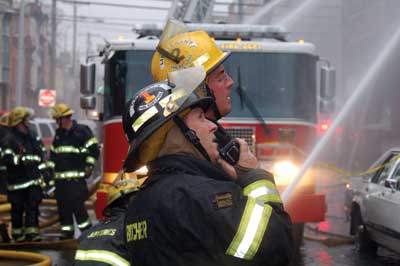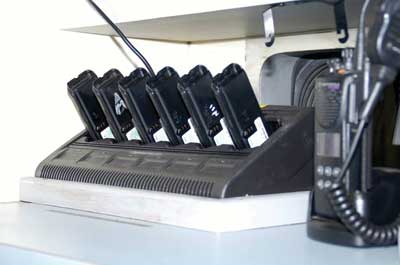BY WILLIAM SHOULDIS
“Readiness to respond” has a direct connection to communication capabilities. In an instant, the incident commander’s (IC) plan of action can change. In recent years, the fire service has been involved in incidents that reflect various risks to first responders. Identifying hazards and assessing dangers are required at the strategic, tactical, and task levels. The frequency of flashover, building collapse, and entanglement has increased. All could require the urgent transmission of a Mayday message. A straightforward communication procedure is the “life blood” of command, control, and coordination at the emergency scene.
Today’s social media and smart phones are vital tools in dealing with communication to the public. Yet, first responders need a highly reliable internal communication system based on the basics. A fundamental command challenge is to have an administrative policy for using the portable radio that is acceptable under all circumstances.
During difficult economic times, community leaders must find the funding to purchase sufficient equipment so that each first responder will have direct access to a portable radio. Likewise, fire department leadership teams have an obligation to create strong operational and organizational rules for rapid radio communication. Experience has proven that safe and efficient deployment of resources hinges on immediate incident information.
 |
| (1) A communication process/procedure is needed. (Photos by Greg Masi.) |
Since 1998, the Centers for Disease Control and Prevention has supported the National Institute for Occupational Safety and Health (NIOSH). The Firefighter Fatality Investigation and Prevention Program is a component of this endeavor. Since its inception, more than 3,000 investigations have been conducted. Very often, there is a common thread. Lack of accountability and poor communication are significant contributing factors in line-of-duty deaths (LODDs). One obvious area for any improvement plan is to have structure-standard operating guidelines (SOGs)-in the verbal information management flow. Response agencies require a realistic rule on the use of the portable radio.
Historically, radio discipline does not exist at many emergency scenes. Unfortunately, many fire companies have no formal plan (SOG) for use of the portable radio, which can breed freelancing on tactical channels.
Organizations without a properly prepared written policy have repeatedly “heard” the consequences-radio traffic is not controlled and radio frequencies quickly become overloaded. The streetwise solution is to develop a meaningful training session that involves much more than turning knobs, swapping war stories, and reading reports. Most after-action reports indicate that as conditions deteriorate, the number of radio transmissions escalates. This fact leads to frustration, conflicts, and stress at pivotal points in the critical decision-making process. Real-time information management is a priority. Delays in deployment of the rapid intervention crew, incident safety officer (ISO), or comprehending a status report can be disastrous.
Data from dispatch records in Philadelphia, Pennsylvania, revealed that during a drug-lab basement fire where two firefighters were trapped and killed, the number of radio transmissions “exploded” within one minute after the Mayday message. Messages were “bonked,” and essential elements of situational awareness were lost. In San Francisco, California, a three-story frame dwelling built on a hillside with a lower-level fire resulted in multiple deaths and a NIOSH investigation. Inadequate accountability and improper communications were cited as contributing causes.
Fire departments have limited budgets but must still strive to increase preparedness. Every member has responsibilities for risk assessment and proper notifications through the chain of command. Each crew member must have the capability to transfer information to isolate issues before they become safety problems.
RADIO PROTOCOL: C.A.R.D.S.
The incident scene is a demanding and dynamic environment. Chiefs, company officers, and working teams must closely monitor conditions. There is a tiered responsibility for receiving and sending messages. Having an easy-to-understand, uncomplicated radio protocol is necessary. Responders must be able to communicate at all times. A department’s communication procedure must be user-friendly. As a field commander, I gave directions that were simple to express and easy to understand-C.A.R.D.S.
C-Completed assignments must be transmitted to the IC. Situational awareness is gained by knowing assignments that are completed (primary search, fire containment) and those that are still pending.
A-Acknowledge all messages. The rationale for establishing division and group supervisors is to improve communication. Company officers and overhead personnel-fire attack, ventilation, search, exposure protection-are inserted into the organizational structure to transfer clear, accurate, and reliable information. Good information from inside a structure leads to good decisions at the command post. Progress/status reports begin with timely replies. Many in the protective services require a full evaluation of scene conditions on a regular cycle. The National Fire Academy recommends a verbal evaluation of conditions from key positions every 10 minutes.
R-Resource requirements will change. The portable radio is an appropriate tool for supervisors to make requests for assistance. Whenever apparatus, personnel, or equipment is needed, the IC should have an adequate reserve in a staging area.
D-Dangerous situations are often discovered by task-level firefighters. An IC is often at a fixed position, which does not allow for continuous observation of all exposures. Radio communication is an advisement of changing conditions. The warning of new hazards must be promptly relayed to the command post. The IC can decide on the best measures. Information on structural stability, excessive fire load, indicators of a deliberately set fire, and many other factors can change the mode of operation from offensive to defensive. At times, an ISO can be assigned to address the current or potential problem.
S-Silence can be the best option to avoid any unnecessary interference. All personnel must stay informed and involved. Providing input is required only whenever any of the four parameters (completed assignment, acknowledgment of a message, resource request, and spotting of dangers) exists. Frequently, the first responder should be a listener rather than a speaker.
 |
| (2) An extra “bank of batteries” is needed because batteries drain and need to be replaced. Successful operations depend on a steady stream of supplies-that means water, air, and fresh batteries. |
A key to continuous improvement is to link operations, equipment, and training. In general, the purpose of emergency scene communication is to provide a common operating picture, increase accountability, and reduce interruptions. Most fire departments need a preincident preparedness plan for the use of a portable radio. A “safety based” system for using the portable radio should be firmly introduced before a promotion and during the distribution of any radio equipment. Having written and enforced policies is a core competency in modern management. There will always be a need for better hardware and advanced digital networks, yet technology can never protect the front line troops without a grass-roots guideline for radio transmissions. Reliable research, textbook theory, experience, and safety initiatives are in total agreement. Those at risk at the emergency scene must have the ability to clearly connect with those individuals making strategic decisions. Missed or mixed messages cause confusion.
The fire service has numerous strengths: the dedication of first responders, solid traditions, and many tools. The portable radio is absolutely a “safety tool” that links the IC to key positions at the emergency scene. Now is the time for a strong standardized system for internal communication. Now is the time to overhaul our operating practices. Now is the time for a firm commitment to “never forget” and to follow up on lessons learned. An all-hazard response plan that reduces serious injuries and LODDs is worthy of our efforts. Ensure that the “communication C.A.R.D.S.” are enforced at your next incident. It has many advantages. It is comprehensive and productive. It will increase the odds of on-scene organizational success. Having a strict rule for fireground communication can be cost saving, resource saving, and ultimately life saving. Take the time to train on the communication process so that everyone goes home.
● WILLIAM SHOULDIS served in line and staff positions with the Philadelphia (PA) Fire Department for 35 years. He is an instructor at the National Emergency Training Center and a guest speaker at the Graduate School at St. Joseph’s University.
William Shouldis will present “Scene Documentation a ‘Streetwise’ Decision” on Friday, April 26, 10:30 a.m.-12:15 p.m., at FDIC 2013 in Indianapolis.
Fire Engineering Archives

